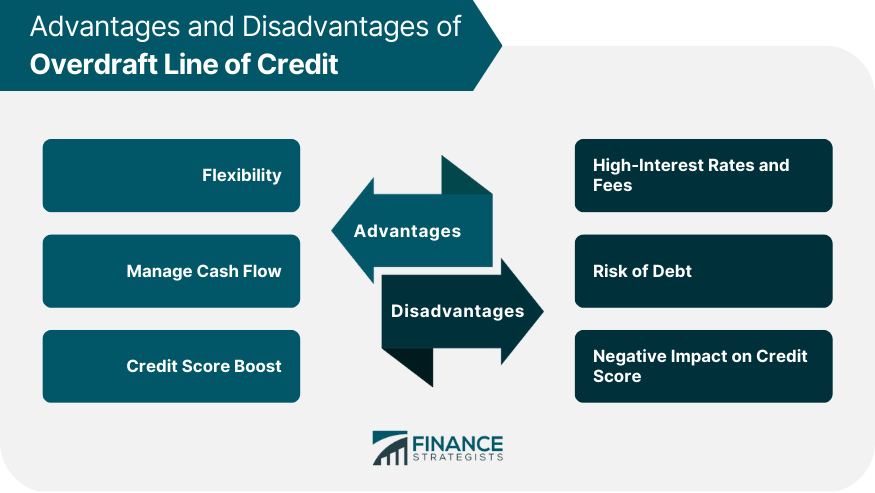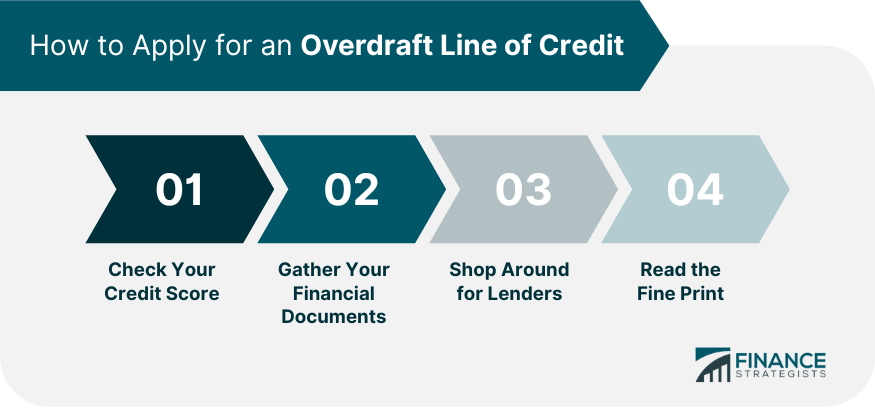An overdraft line of credit is a type of loan that allows you to borrow money up to a certain limit whenever you need it. Unlike traditional loans, you only pay interest on the amount you borrow, not the full credit limit. If you're looking for a flexible way to manage your cash flow, an overdraft line of credit may be a good option for you. An overdraft line of credit works like a credit card, in that you have a credit limit that you can draw from whenever you need to. However, unlike a credit card, you can access the funds directly from your checking account. When you apply for an overdraft line of credit, the lender will set a credit limit for you based on your creditworthiness. This limit is the maximum amount you can borrow at any given time. You don't have to use the entire credit limit all at once, and you can draw from it whenever you need to. An overdraft line of credit can be used for a variety of purposes, such as paying bills, covering unexpected expenses, or managing cash flow during lean periods. It is a good option if you have irregular income or expenses, or if you need to cover unexpected costs that you can't afford to pay out of pocket. An overdraft line of credit has several advantages that make it a popular choice for individuals and businesses alike. One of the main advantages of an overdraft line of credit is its flexibility. You can use it to cover a variety of expenses, and you only pay interest on the amount you borrow, not the full credit limit. This means that you can borrow as much or as little as you need, and only pay interest on what you use. An overdraft line of credit can also help you manage your cash flow. If you have irregular income or expenses, an overdraft line of credit can provide a cushion to help you cover unexpected costs or bills. It can also help you avoid overdraft fees, which can be costly if you don't have enough money in your checking account to cover a transaction. Using an overdraft line of credit responsibly can also help boost your credit score. By making timely payments and using the credit limit responsibly, you can show lenders that you're a responsible borrower, which can help improve your credit score over time. While an overdraft line of credit can be a useful tool, it is important to understand the potential drawbacks before you apply for one. One of the biggest disadvantages of an overdraft line of credit is the high-interest rates and fees that may be associated with it. Because it is an unsecured loan, lenders may charge higher interest rates to offset the risk of lending money without collateral. In addition, there may be fees for using the overdraft line of credit, such as transaction fees, annual fees, or maintenance fees. Another disadvantage of an overdraft line of credit is the risk of falling into debt if you're not careful. Because it is a revolving line of credit, it is easy to borrow more than you can afford to repay. This can lead to a cycle of borrowing and repayment that can be difficult to break and can ultimately lead to financial trouble. If you don't repay your overdraft line of credit on time, it can also have a negative impact on your credit score. Late payments or missed payments can lower your credit score, making it more difficult to qualify for loans or credit cards in the future. If you're interested in applying for an overdraft line of credit, here's what you need to know. Before you apply for an overdraft line of credit, it is a good idea to check your credit score. Lenders will use your credit score to determine your creditworthiness and set your credit limit. If you have a low credit score, you may not qualify for an overdraft line of credit, or you may be offered a lower credit limit and higher interest rates. To apply for an overdraft line of credit, you'll need to provide documentation of your income and expenses, as well as any other debts you have. This may include pay stubs, bank statements, tax returns, and other financial documents. When you're ready to apply for an overdraft line of credit, it is important to shop around for lenders to find the best terms and rates. You can start by checking with your bank or credit union, but you may also want to consider online lenders or peer-to-peer lending platforms. Before you sign up for an overdraft line of credit, be sure to read the fine print and understand the terms and conditions. Pay attention to the interest rates, fees, repayment terms, and credit limit. If you decide to use an overdraft line of credit, it is important to use it responsibly to avoid falling into debt. Here are some tips to help you use it wisely. One of the most important things you can do when using an overdraft line of credit is to create a budget. This will help you understand your income and expenses and make sure you don't borrow more than you can afford to repay. It will also help you identify areas where you can cut back on spending to reduce your reliance on credit. When you're using an overdraft line of credit, it can be tempting to borrow more than you need. However, it is important to only borrow what you need and can afford to repay. Resist the urge to max out your credit limit, and only borrow what you need to cover your expenses. To avoid falling into debt or damaging your credit score, it is important to make your payments on time. Set up automatic payments or reminders to make sure you don't miss a payment. If you're having trouble making your payments, contact your lender to see if they can offer a repayment plan or other assistance. An overdraft line of credit can be a useful tool for managing cash flow and covering unexpected expenses. However, it is important to understand the potential drawbacks and use it responsibly to avoid falling into debt. By creating a budget, borrowing only what you need, and making timely payments, you can use an overdraft line of credit to your advantage and improve your credit score. When applying for an overdraft line of credit, it is important to shop around for lenders and read the fine print to make sure you understand the terms and conditions. With the right approach, an overdraft line of credit can be a valuable financial tool to help you achieve your goals and manage your cash flow.What Is an Overdraft Line of Credit?
Understanding Overdraft Line of Credit
Advantages of Overdraft Line of Credit
Flexibility
Manage Cash Flow
Credit Score Boost
Disadvantages of Overdraft Line of Credit
High-Interest Rates and Fees
Risk of Debt
Negative Impact on Credit Score

How to Apply for an Overdraft Line of Credit
Check Your Credit Score
Gather Your Financial Documents
Shop Around for Lenders
Read the Fine Print
Make sure you understand how and when you'll be required to make payments, and what will happen if you miss a payment.
Tips for Using Overdraft Line of Credit Responsibly
Create a Budget
Borrow Only What You Need
Make Timely Payments
Conclusion
Overdraft Line of Credit FAQs
An overdraft line of credit is a type of loan that allows you to borrow money up to a certain limit whenever you need it.
It works like a credit card, in that you have a credit limit that you can draw from whenever you need to. However, unlike a credit card, you can access the funds directly from your checking account.
It provides flexibility, helps manage cash flow, offers flexibility in repayment, and can help improve your credit score.
The high-interest rates and fees that may be associated with it, the risk of falling into debt if not used responsibly, and the negative impact on credit score if payments are missed or late.
To apply for an overdraft line of credit, you need to check your credit score, gather your financial documents, shop around for lenders, and read the fine print to understand the terms and conditions.
True Tamplin is a published author, public speaker, CEO of UpDigital, and founder of Finance Strategists.
True is a Certified Educator in Personal Finance (CEPF®), author of The Handy Financial Ratios Guide, a member of the Society for Advancing Business Editing and Writing, contributes to his financial education site, Finance Strategists, and has spoken to various financial communities such as the CFA Institute, as well as university students like his Alma mater, Biola University, where he received a bachelor of science in business and data analytics.
To learn more about True, visit his personal website or view his author profiles on Amazon, Nasdaq and Forbes.











